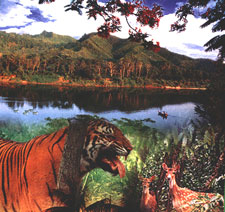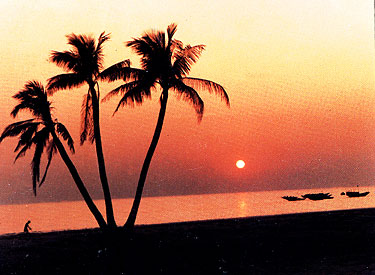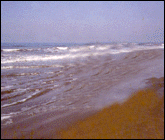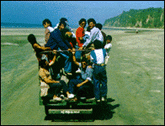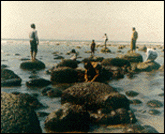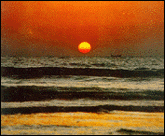Sundarbans
Located at
about 320km. West of
Dhaka. Here in the south, spread over an area of
about 6000
sq.km.
of delta swamps along the coastal belt of Khulna is
the
biggest mangrove forest, Sundarbans
(beautiful forest) - the home of the
Royal
Bengal Tiger. These dense mangrove forests are
criss-crossed by a
network of
rivers and creeks. One find here tides flowing in two directions
in the
same
creek and often tigers swimming across a river or huge crocodiles
basking in the
sun
. Other wildlife in this region is cheetahs, spotted deer, monkeys,
pythons,
wild bears and
hyenas.
The forest is
accessible by river from Khulna and Mongla. There are rest houses for
the
visitors
to stay
and enjoy the unspoiled nature with all its charm and
majesty.
Spending some times inside the
forest
can be a rare treat for the lovers
of
nature. BPC offers package tours to Sundarbans.
Kaptai
Kaptai is an
upazila under Rangamati
district. It is famous for hydro-electric project. A panoramic
man-made
lake
called Kaptai lake (680-sq. km.) in the midst of hills has added to its
beauty. A pleasant and
picturesque
drive of 64 km.
from Chittagong brings you to huge expanse of emerald and blue water
ringed
with
tropical
forest. Only 3 km. from Kaptai along Chittagong road, lies the ancient Chit Morong Buddhist
temple having beautiful Buddhist statues.
Kuakata
A rare scenic beauty spot on the
southern
most tip of Bangladesh in the district of Patuakhali.
It has a wide
sandy beach
from where one can get the unique opportunity of seeing both the sunrise
and
sunsetting. It is located at a distance of 70 km. from the district
headquarters
of Patuakhali.
Accessible by road, by air to
Barisal and then by road,
by river
vessel.
Kuakata, locally
known as Sagar Kannya (Daughter of the Sea) is a rare scenic
beauty spot
on the
southernmost tip of Bangladesh. Kuakata in Latachapli union
under
Kalapara Police Station of
Patuakhali
district is about 30 km in
length
and 6 km in breadth. It is 70 km from Patuakhali district
headquarters
and
320 km from Dhaka. At Kuakata excellent combination of the
picturesque
natural beauty,
sandy beach, blue sky, huge expanse of water of
the Bay
and evergreen forest in really
eye-catching.
Kuakata is
one of the rarest places which has the
unique beauty of offering the full view
of the rising
and setting
of
crimson sun in the water of the Bay of Bengal in a calm
environment.
That
perhaps
makes kuakata one of the world's unique beaches. The long
and wide
beach at Kuakata has a
typical natural setting. This sandy beach
has
gentle slopes into the Bay of Bengal and bathing
there is as
pleasant as
is walking or diving. Kuakata is truly a virgin beach-a sanctuary
for
migratory
winter birds, a series of coconut trees, sandy beach of
blue
Bay, a feast for the eye.
Forest, boats
plying in the Bay of
Bengal with
colourful sails, fishing, towering cliffs, surfing waves
everything
here
touches every visitor's heart. The unique customs and costumes of
the 'Rakhyne' tribal
families and Buddhist Temple of about hundred years
old
indicate the ancient tradition and
cultural heritage, which are
objects of
great pleasure Kuakata is the place of pilgrimage of
the Hindus
and
Buddhist communities. Innumerable devotees arrive here at the
festi
val of Rush Purnima' and 'Maghi Purnima'. On these two days they take
holy bath
and
traditional fairs are held here. All these additional offers
to
panoramic beauty make
the beach more attractive to the visitors.
One
should visit Kuakata and discover the
lovely grace of
Bangladesh.
Tamabil
& Jaflong
Situated amidst
splendid panorama, Tamabil is a border outpost on Sylhet-Shilong road,
about 55
km.
away from Sylhet town. Beside enchanting views of the area one can
also have
a glimpse
of the
waterfall across the border from Tamabil. Jaflong is
also a
scenic spot nearby amidst tea
gardens
and rare beauty of rolling stones
from
hills.
Mainamati
An isolated low, dimpled range of
hills, dotted -with more than 50 ancient Buddhist settlements
of the 8th
to 12th
century A.D. known as Mainamati-Laimai range are extended through the
center
of
the district of Comilla.
Salban Vihara, almost in the
middle of the Mainamati-Lalmai hill range consists of 115 cells,
built
around
a
spacious courtyard with cruciform temple in the centre facing its only
gateway
complex
to the north
resembling that of the Paharpur Monastery.
Kotila Mura situated on a
flaftened hillock, about 5 km north of Salban Vihara inside the Comilla
Cantonment
are is picturesque Buddhist establishment. Here three stupas
are
found side by side representing
the Buddhist "Trinity" or three jewels
i.e. the
Buddha, Dharma and Sangha.
Charpatra Mura is an isolated
small oblong shrinesituated about 2.5 krn. north-west of kotila
Mura
stupas.
The
only approach to the shrine is from the East through agateway which
leads to a
spacious
hall.
The Mainamati site Museum
has a rich and varied collection of copper plates, gold and silver
coins
and 86
bronze objects. Over 150 bronze statues havo been recovered mostly from
the
monastic cells,
bronze stupas, stone sculptures and hundreds of
terracotta
plaques each measuring on an
average of 9" highly and 8" to 12" wide.
Mairiamati is only 114 km. from Dhaka
City and is just
a day's trip by road on way to
Chittagong.
Cox's Bazar
Located at a
distance of 152 km. to the south of Chittagong, Cox's Bazar is the
tourist capital
of Bangladesh. Having the world's longest unbroken (120
km.)
beach sloping gently down to
the blue waters of the Bay of Bengal
against the
picturesque background of a chain of hill
covered with deep green
forests, Cox's
Bazar is one of the most attractive tourist spots in
the world. Miles of
golden
sands, towering cliffs surfing waves, rare conch shells, colorful
pagodas,
Buddhist temples and tribes, delightful seafood - these are specialties
of Cox's
Bazar.
The beach is
good for bathing, sunbathing and swimming. The breath-taking beauty of
the
sun-setting behind the waves of the sea is captivating. Attractive local
variety
of cigars and
handloom products of the Rakhyne tribal families are good
buys.
Their unique customs and
costumes attract visitors.
Cox's Bazar is
connected both by air
and road from Dhaka and Chittagong. Visits to the
fascinating picnic spot at Himchari, Teknaf,
Buddhist temple at Ramu and nearby island of
Sonadia, St. Martin and
Mohaskhali
are memorable experience of one's lifetime.
The Aggameda Khyang, Cox's Bazar : Equally elaborate in plan,
elevation and decoration is
the
Aggameda Khyang near the entrance to the Cox's Bazar town
which
nestles at the foot of a
hill under heavy cover of a stand of
large trees.
The main sanctuary-cum-monastery is carried
on a series of round
timber
columns, which apart from accommodating the prayer chamber and
an
assembly
hall, also is the repository of a large of small bronze Buddha
images-mostly of
Burmese origin-- and some old manuscripts. Beyond
the
main khyang to the south there is
an elevated wooden pavilion and a
smaller brick temple with a timber and corrugated metal root.
Apart from
bearing an inscription in Burmese over its entrance the temple
contains
some large
stucco and bronze Buddha images.
Himchari
: It is
about 32 km. South of Cox's Bazar along the beach, a nice
place
for picnic
and shooting. The famous "Broken Hills" and waterfalls here are
rare
sights.
Inani
: It is
about 32 km. South of Cox's Bazar and just on the beach, with the
sea
to
the west and a background of steep hills to the east. Inani casts a
magic
spell on those
who step into that dreamland. It is only half an
hour's
drive from Cox's Bazar and an ideal place
for Sea-bathing and
picnic.
Maheskhali :
An island off the coast of Cox's Bazar. It has an area
of 268sq.km
Through the centre of the island and
along the
eastern coast line rises a range of low hills,
300 feet high; but
the
coast to the west and north is a lowlying treat, fringed by
mangrove
jungle.
In the hills on the coast is built the shrine of Adinath,
dedicated to siva. By its side on the same
hill is Buddhist
Pagoda.
Ramu :
This is a typical
Buddhist village, about 16 km. from Cox's Bazar, on the main
road
to
Chittagong. There are monasteries, khyangs and pagodas containing
images
of Buddha
in gold, bronze and other metals inilaid with precious
stones.
One of the most interesting of these temples is on
the bank
of the Baghkhali river. It houses
not only interesting relics and
Burmes
handicrafts but also a large bronze statue of Buddha
measuring
thirteen
feet high and rests on a six feet high pedestal. The wood carving
of this
khyang is very delicate and refined.
The village has a
charm of its own. Weavers ply there trade
in open workshops and craftsmen
make handmade cigars in their
pagoda like
houses.
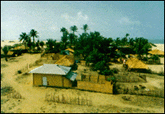
Sonadia
Island :
It is about seven kilometer of Cox's Bazar
and about
nine square kilometer in area. The western side of the
island is
sandy and different kinds of shells
are found on the beach. Off
the
northern part of the island, there are beds of window pane
oysters. During
winter, fisherman set up temporary camps on the island and dry
their
catches
of sea fish.
Teknaf
:
Southernmost tip of Bangladesh, Teknaf situated on the Naaf river
and just
at the end of the hilly regions of the district. Mayanmar is on
the
opposite bank of Naaf river. Wild
animals and birds are available
but the
most interesting thing is a journey on the river. Wide sandy
beach
in the
backdrop of high hills with green forests is an enchanting scene
never to
be forgotten.
Mahasthangarh
Located at a
distance of 18 km. to the north of
Bogra town. Mahasthangarh is the oldest
archaeological site of
Bangladesh on the
western bank of river Karotoa. The spectacular site
is an imposing
landmark in
the area having a fortified long enclosure. Beyond the fortified area,
other
ancient ruins fan out within a semi-circle of about 8-km. radius.
Several
isolated mounds,
the local names of which are Govinda Bhita Temple,
Khodai
Pathar Mound, Mankalir Kunda,
Parasuramer Bedi, Jiyat Kunda etc.
surround the
fortified city.
This
3rd century BC archaeological site is still held to be of great sanctity
by the
Hindus. Every
year (mid-April) and once in every 12 years (December)
thousands
of Hindu devotees join the
bathing ceremony on the bank of river
Karatoa. A
visit to the Mahasthangarh site museum will
open up for one a wide
variety of
antiquities, ranging from terracotta objects to gold ornaments
and coins
recovered from the site.
Also
noteworthy are the shrine of Shah Sultan Bulki Mahisawary and Gokul Medh
in the
neighborhood of Mahasthangarh.
Paharpur
In
Paharpur, a small village 5 km. west of Jamalganj railway station in the
greater Rajshahi district,
the remains of the most important and the
largest known monastery south of the Himalayas has
bee excavated. This
8th
century A.D. archaeological find covers approximately an area of 27
acres
of
land. The entire establishment occupies a quadrangular court, measuring
more
than 900 ft. and
from 12fh to 15ft. in height with elaborate gateway
complex
on the north. There are 45 cells on
the north and 44 in each of other
three sides with a total number of 177 rooms. The architecture
of the
pyramidal cruciform temple is profoundly influenced by those of
South-East Asia,
especially
Myanmar and Java. It had taken its name from a high mound,
which
looked like pahar or hillock.
A site museum built recently houses the
representative coactions of objects recovered from
the area. The
excavated
findings have also been preserved at the Veranda Research museum at
Rajshahi. The antiquities of the museum include terracotta plaques,
images
of different gods
and goddesses, potteries, coins, inscriptions,
ornamental
bricks and other minor clay objects .
It has been declared as a
World Heritage site by UNESCO.
Ahsan Manzil
Early History Of
Pad
The palace has enjoyed a varied history, starting from being Rang
Mahal (of Sheikh Enayetullah, a zamindar
of Jamalpur pargana barisal during the time of the mughals) to a french trading center. nawab khaja alimullah
bought it from the
French in 1830 and converted it into his residence, effecting necessary
reconstruction and
renovations. The final reconstruction was done by
Martin.
[] Construction
The construction of the palace was begun in 1859 and completed in
1872. Abdul Ghani named it
Ahsan Manzil after his son nawab khaja ahasanullah . The newly built palace first
came to be known
as the Rang Mahal. On April 7, 1888, a tornado caused
severe damage to Ahsan Manzil -- Andar Mahal,
the older part of the
palace, was completely devastated. During the reconstruction of the
Andar Mahal a
good part of the palace was overhauled and repaired, and
the exquisite dome of the present Rang Mahal
was added. Ahsan Manzil was
again damaged by an earthquake in 12 June 1897 and again repaired by
the
Nawab Ahsanullah.
[] Glory days

Nawab Sir Salimullah with his family in front of Ahsan Manzil
In 1874, Lord Northbrook, governor general of India attended
an evening function in the palace when
he came to lay the foundation of
a water works installed by Nawab Abdul Ghani. In 1888, Lord Dufferin
also accepted the hospitality offered at Ahsan Manzil. In 1904 Lord
Curzon, on a visit to East Bengal,
stayed in this palace on 18 and 19
February to win public support for the proposed Partition of Bengal.
Almost all political activities of nawab khaja solimullah centred round this palace. Ahsan
Manzil was the
cradle of the all india muslim liugh . With the decline of thenawab`s of dhaka Ahsan Manzil also
started to
decline.
[] Decline
When in 1952 the Dhaka Nawab State was acquired under the east bangle estate acquisition act ,
it became impossible for
the successors of the Nawabs to maintain the palace due to financial
constraints.
nawab khaja habibullah started living at
Paribag Green House soon after the acquisition of the zamindari.
. The
palace was soon on the verge of collapse as successors rented out rooms
without considering its
dignity. Over the years illegal occupants turned
the place into a filthy slum.
[] Renovation
Recognizing the historical and architectural importance of the Ahsan
Manzil, the government of Bangladesh
took the initiative to renovate it.
In 1985 Ahsan Manzil and its surroundings were acquired. After the
completion of the renovation work in 1992 under the supervision of the
Directorate of Public Works and
Architecture, it was brought under the
control of Bangladesh National Museum (20 September 1992).
A museum has
been established there.
[] Description

Ahsan Manzil has now been converted into a museum and a popular tourist
attraction of old dhaka.
Ahsan Manzil is one of the most significant architectural monuments
of Bangladesh.
Established on a raised
platform of 1 metre, the two-storied palace
measures 125.4 m by 28.75 m. The height of the ground floor
is 5 metres
and that of the first floor 5.8 metres. There are porticos the height of
the ground floor, both on
the northern and southern sides of the
palace. An open spacious stairway comes down from the southern
portico,
extending onto the bank of the river through the front garden. There was
once a fountain in the
garden in front of the stairs, that does not
exist today. The spacious north and south verandas of both the
floors
rest on semicircular arches. The verandas and rooms are covered with
marble.
To construct the dome of Ahsan Manzil, the square room on the ground
floor was given a round shape
with brickwork in the corners. The room
was then given an octagonal shape near the roof by squinches
. This
octagonal shape took the form of the drum of the dome. Finally, the
kumud kali (buds of lotus)
shaped dome was constructed by gradually
slanting the eight corners to the peak. The dome is 27.13 m
above the
ground.
| Bangladesh: Flashback |
Dhaka
(Bangladesh), March 12th 2008
|
|
|
Sometimes you travelled through a country that gave you a
very special and good feeling while
being there. Bangladesh is such a
country. But, why? That is a question that is difficult to answer,
because Bangladesh is a country with two faces. Let’s give it a try.
Let’s start with the absolute highlight of Bangladesh. Its
people! It is really incredible to experience
how warm-hearted and
friendly the Bangladeshi people are. The people really love the fact
that you
bring a visit to their country, even if it’s difficult for them
to understand why the hell somebody wants
to visit their country. And
like we said, that is a difficult question. The Bangladeshi people have a
pretty
good image about their selves and excuse themselves often about
the low quality tourist infrastructure that
they can offer. But they are
proud on their hospitality and that’s justified. Bangladeshi people are
always
interested in a conversation. It doesn’t matter if you are in
the bus, or waiting for a street to cross,
there is always somebody who
wants to have a chat with you. Of course, these conversations are
often
short and superficial, but that’s because of their limited knowledge of
the English language (
and our non existing knowledge of the Bangla
language). But even with this ‘handicap’, they won’t let the
opportunity
pass to have a short chat with a foreigner. Wherever you go in
Bangladesh, people are always
rewarding you with a row of white shining
teeth. You are really a guest in their country.
|
|
|
Edwin enjoying
a cocunut at the beach in Cox's Bazaar
|
|
But there is also a different side
of the medal. There must be a reason why so few travellers decide to
spend
their holiday in Bangladesh. The most important fact is that
foreigners often have a negative image of
Bangladesh. Bangladesh is
often associated with extreme poverty (40% of the people have an income
of
less than one US-dollar a day). Besides that, the country often gets
the headlines when it is hit by a natural
disaster, like the cyclone
Sidr in November 2007, or when there is a ferry accident in where many
people lost
their life. Finally, Bangladesh is more and more frequent in
the news regarding the fact that Muslim extremism
is growing within the
country. But, Bangladesh has a bigger disadvantage regarding tourism.
It has no big
highlights. It has no Taj Mahal, Angkor Wat, Machu Pichu
or Borobodur. That is a problem, because most
traveller decide about
their next travel destination by looking to the highlights they want to
visit. And if you
have no highlight, the chances are small that people
decide to bring you a visit. But if you look a little bit further,
there
are some interesting highlights in Bangladesh. One of the greatest
places to visit in Bangladesh is the
largest remaining mangrove forest
in the world, the Sundarbans. But unfortunately, a big part of the
Sundarbans
is also located in India. And indeed, that is where the
majority of the tourists go. Another nice place to visit
is Dhaka,
Bangladeshi’s capital city. The first impression you probably have is
that the city is chaotic.
But if you take the time to explore the city
in more detail, you probably are going to like it. Especially
Old Dhaka
is a great place to stroll around. The trip between Sundarbans and Dhaka
can be done by ferry.
Taking one of the ferries (preferably the Rocket
Steamer) is a great way to enjoy the typical Bangladeshi
ferry life and
to get in touch with the local people. Be prepared to pose many times
for a picture! Finally,
one should consider bringing a visit to the
south-eastern part of the country. It is the place to enjoy beach
life
Bangladeshi style at one of the beautiful beaches in Cox’s Bazaar or
Saint Martin’s Island.
We liked Saint Martin’s Island more, because it
also a great place to observe traditional fishing life. Do not
expect to
visit something like Santa Monica Beach or the Costa de Sol. It is
beach life Bangladeshi style.
But that’s also fun. While being in the
south-eastern part of Bangladesh, you could consider bringing a visit
to
the Chittagong Hill Tracts, if the security situation permits. |
|
|
Sadarghat
harbour in Old Dhaka after arriving with the Rocket Steamer
|
|
Travelling in Bangladesh can be
tiring. This is the result of the fact that you get a lot of attention.
Wherever you
go, you will be in the spot lights, if you like it or not.
Some people say that you have to go to Bangladesh if you
want to know
how it feels to be famous. We experienced that it is even hard to find
privacy in your hotel room
. When other hotel guests found out in what
room we were staying, they knocked on our door late in the
evening to
have a chat with us. Of course, the intention is always good, but
sometimes it is just a little too much.
Bangladeshi people give you a
lot of energy, but sometimes they suck all the energy out of you.
Another thing
that you should not expect is a great Bangladeshi cuisine.
At least not if you are travelling on a tight budget.
Eating in the low
end restaurants is monotonous and often very fat. The meals are often a
combination of rice
or bread (roti/paranta), with sabji (vegetable
curry) and dahl (lentil soup). If you are lucky to be in Bangladesh
when
there is no H5N1-bird flu, luck that we did not have, it is also safe
to eat some kind of chicken curry.
But, there is hope. If you want to
spend a little bit more money, you can go to one of the restaurants of
the
top end hotels. They often offer a breakfast, lunch and dinner
buffet, where you can eat as much as you can
for approximately € 6,- per
person. And the quality is often very good. To be honest, this is what
we did
several times at the end of our Bangladeshi journey.
Despite the fact that travelling through Bangladesh can
be
tiring and that there are no famous highlights to see, it is a great
country to visit. Whatever disadvantage
you encounter, the friendliness
and hospitality of the Bangladesh people compensates it. If you are
looking
for a special country to visit, pretty of the beaten track,
Bangladesh is a great destination to explore. And
if a visit to only
Bangladesh is a little bit too much for you, consider a combined visit
of Bangladesh and India.
We travelled last months through north-eastern
India and Bangladesh, and the following itinerary is a great
one if you
want to combine these countries. Start with your journey in Siliguri
(India) from where you can
bring a visit to the spectacular Indian
Himalayas. Afterwards, travel east to the state of Assam where you
can
observe the wild elephants and rhino’s in the fabulous National Park of
Kaziranga ). Than, travel to the
state of
Meghalaya where you can walk on the unique living root bridges , before crossing to Sylhet in
Bangladesh.
After enjoying a visit to one of the many tea estates, you are ready for
Dhaka. Take a ferry
(Rocket Steamer) to Khulna where you can organise
your trip into the Sunderbans , after which you can
cross back to India
for some final days in Kolkatta. The best of two worlds! |
|









